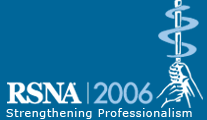
Abstract Archives of the RSNA, 2006
SSM11-02
Last Fluoroscopy Hold: A Potential Means for Reducing Radiation in Gastrointestinal Radiography & Fluoroscopy
Scientific Papers
Presented on November 29, 2006
Presented as part of SSM11: Gastrointestinal (Fluoroscopy)
Aviv Hirschenbein MD, Presenter: Medical Director, CMT Medical Technologies Ltd, Israel
Michalle Soudack MD, Abstract Co-Author: Nothing to Disclose
Udi Dafni PhD, Abstract Co-Author: Vice President, CMT Medical Technologies Ltd
Sergey Shabelyansky MS, Abstract Co-Author: Nothing to Disclose
Sharon Katz BENG, Abstract Co-Author: Employee, CMT Medical Technologies Ltd
Jacob Sosna MD, Abstract Co-Author: Research grant, Koninklijke Philips Electronics NV
Last image hold (LIH) commonly used in R&F systems displays only the single last image. Fluoro store (FS) saves to memory all image frames of a whole fluoroscopic examination and is therefore not practical in certain clinical situations. Last Fluoroscopy Hold (LFH) is a new advanced feature that dynamically stores only the last current sequence of fluoroscopy images for instant replay, editing and storage in Radiography and Fluoroscopy systems (R&F) without the need for operator pre-setting. Our aim was to compare the effect on fluoroscopy time between the 3 techniques in a laboratory set-up.
The LFH feature was evaluated on a tissue-equivalent phantom simulating a dynamic event. We used a mechanical arm that moved in random unpredictable movements on the fluoroscopic field of view with a circle in the middle. Nine volunteers (7 experienced radiology technicians and 2 experienced Radiologists) were recruited for the experiment. Each had to repeatedly trace the position of the arm and record when it's tip was inside the circle (TACP =Tip Arm Circle Position) using the LFH, LIH and FS and comparing the time it took to operate each different systems. The number of relevant diagnostic images acquired by each system was also compared
36% (59/168), of LIH acquisitions captured the TACP whereas 100% (70/70)of LFH and FS acquisitions captured the TACP. Percentage of relevant images in LIH was 36% 100% with LFH and 0.04% with FS. Average fluoroscopy time was 13.6 sec for LIH, 6.5 sec for LFH and 10.7 sec for FS per sequence. Average fluoroscopy time for acquiring TACP was significantly higher using LIH compared to LFH (9.75/1) and to FS (10/6).In order to operate the FS a pre-setting time of average 12 sec was needed
LFH is a reliable feature that dynamically holds the last fluoroscopy sequence for online reviewing, editing and storage. LFH significantly reduced fluoroscopy time and increased the number of available relevant diagnostic images compared to LIH and FS. Clinical evaluation is presently underway way
LFH may significantly reduce fluoroscopy time and exposure dose, and increase relevant diagnostic images from R&F systems
Hirschenbein, A,
Soudack, M,
Dafni, U,
Shabelyansky, S,
Katz, S,
Sosna, J,
Last Fluoroscopy Hold: A Potential Means for Reducing Radiation in Gastrointestinal Radiography & Fluoroscopy. Radiological Society of North America 2006 Scientific Assembly and Annual Meeting, November 26 - December 1, 2006 ,Chicago IL.
http://archive.rsna.org/2006/4436278.html

